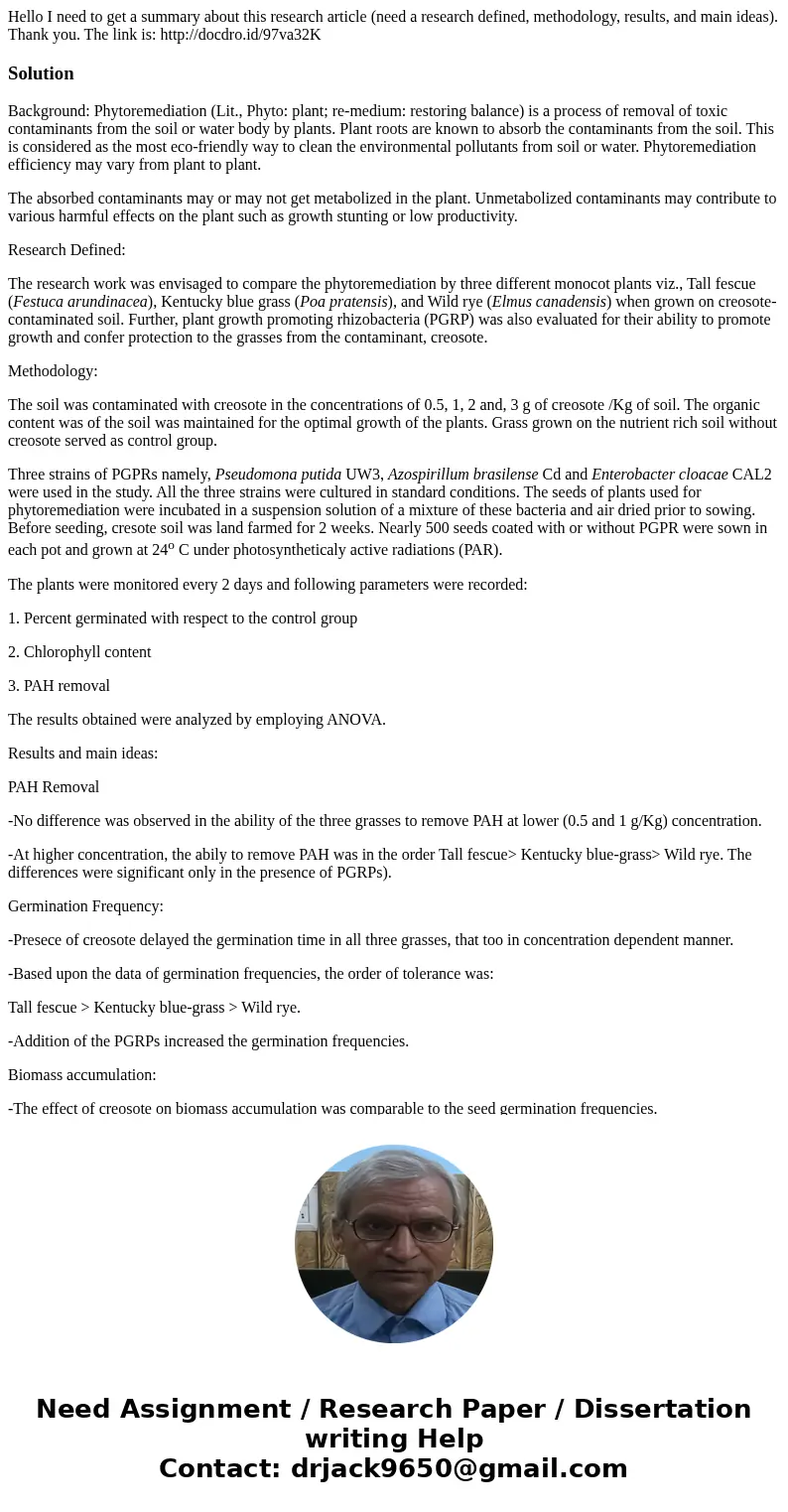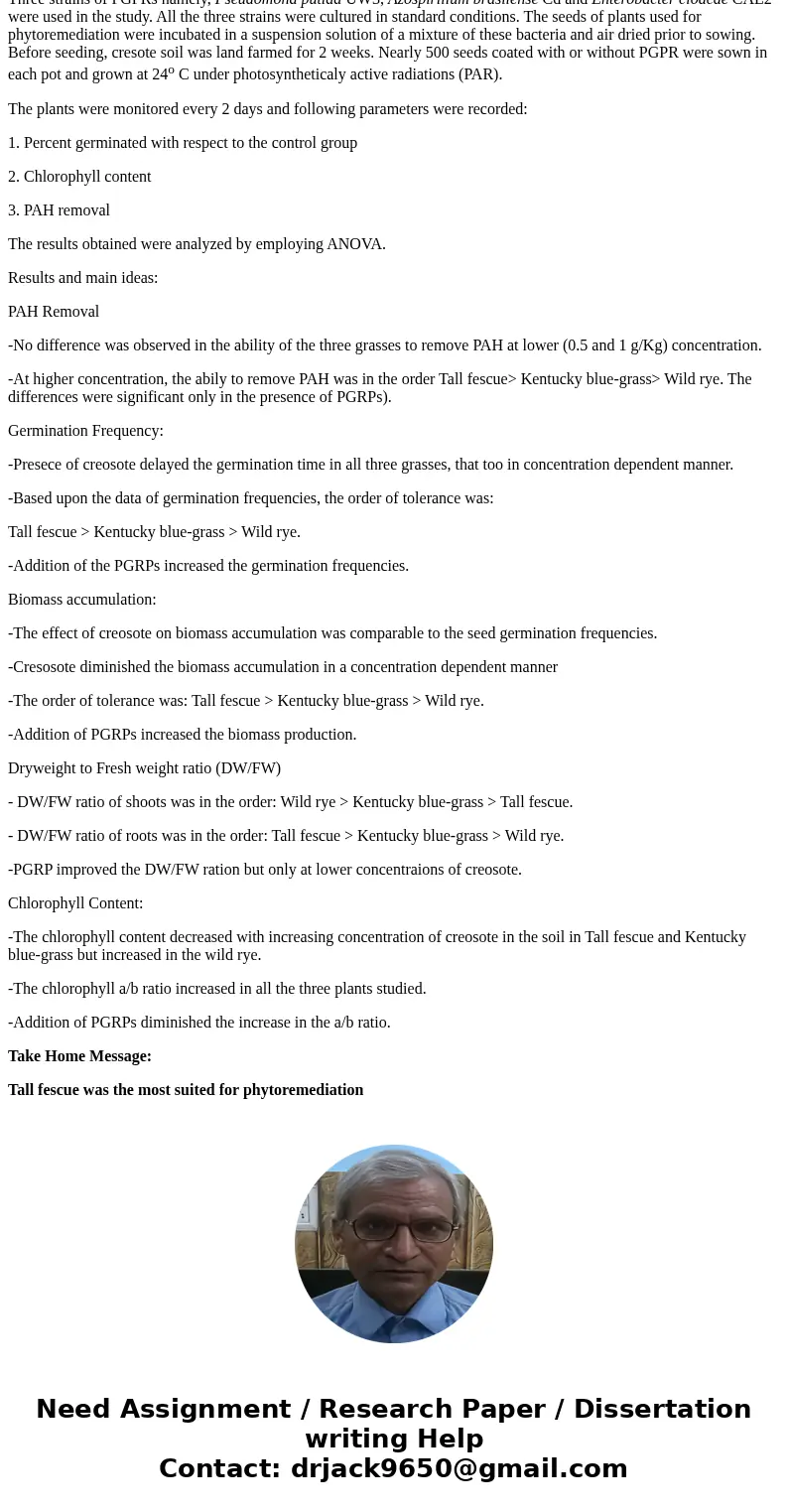Hello I need to get a summary about this research article ne
Hello I need to get a summary about this research article (need a research defined, methodology, results, and main ideas). Thank you. The link is: http://docdro.id/97va32K
Solution
Background: Phytoremediation (Lit., Phyto: plant; re-medium: restoring balance) is a process of removal of toxic contaminants from the soil or water body by plants. Plant roots are known to absorb the contaminants from the soil. This is considered as the most eco-friendly way to clean the environmental pollutants from soil or water. Phytoremediation efficiency may vary from plant to plant.
The absorbed contaminants may or may not get metabolized in the plant. Unmetabolized contaminants may contribute to various harmful effects on the plant such as growth stunting or low productivity.
Research Defined:
The research work was envisaged to compare the phytoremediation by three different monocot plants viz., Tall fescue (Festuca arundinacea), Kentucky blue grass (Poa pratensis), and Wild rye (Elmus canadensis) when grown on creosote-contaminated soil. Further, plant growth promoting rhizobacteria (PGRP) was also evaluated for their ability to promote growth and confer protection to the grasses from the contaminant, creosote.
Methodology:
The soil was contaminated with creosote in the concentrations of 0.5, 1, 2 and, 3 g of creosote /Kg of soil. The organic content was of the soil was maintained for the optimal growth of the plants. Grass grown on the nutrient rich soil without creosote served as control group.
Three strains of PGPRs namely, Pseudomona putida UW3, Azospirillum brasilense Cd and Enterobacter cloacae CAL2 were used in the study. All the three strains were cultured in standard conditions. The seeds of plants used for phytoremediation were incubated in a suspension solution of a mixture of these bacteria and air dried prior to sowing. Before seeding, cresote soil was land farmed for 2 weeks. Nearly 500 seeds coated with or without PGPR were sown in each pot and grown at 24o C under photosyntheticaly active radiations (PAR).
The plants were monitored every 2 days and following parameters were recorded:
1. Percent germinated with respect to the control group
2. Chlorophyll content
3. PAH removal
The results obtained were analyzed by employing ANOVA.
Results and main ideas:
PAH Removal
-No difference was observed in the ability of the three grasses to remove PAH at lower (0.5 and 1 g/Kg) concentration.
-At higher concentration, the abily to remove PAH was in the order Tall fescue> Kentucky blue-grass> Wild rye. The differences were significant only in the presence of PGRPs).
Germination Frequency:
-Presece of creosote delayed the germination time in all three grasses, that too in concentration dependent manner.
-Based upon the data of germination frequencies, the order of tolerance was:
Tall fescue > Kentucky blue-grass > Wild rye.
-Addition of the PGRPs increased the germination frequencies.
Biomass accumulation:
-The effect of creosote on biomass accumulation was comparable to the seed germination frequencies.
-Cresosote diminished the biomass accumulation in a concentration dependent manner
-The order of tolerance was: Tall fescue > Kentucky blue-grass > Wild rye.
-Addition of PGRPs increased the biomass production.
Dryweight to Fresh weight ratio (DW/FW)
- DW/FW ratio of shoots was in the order: Wild rye > Kentucky blue-grass > Tall fescue.
- DW/FW ratio of roots was in the order: Tall fescue > Kentucky blue-grass > Wild rye.
-PGRP improved the DW/FW ration but only at lower concentraions of creosote.
Chlorophyll Content:
-The chlorophyll content decreased with increasing concentration of creosote in the soil in Tall fescue and Kentucky blue-grass but increased in the wild rye.
-The chlorophyll a/b ratio increased in all the three plants studied.
-Addition of PGRPs diminished the increase in the a/b ratio.
Take Home Message:
Tall fescue was the most suited for phytoremediation


 Homework Sourse
Homework Sourse